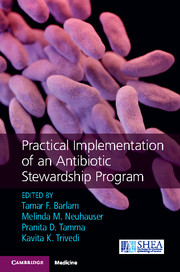14 results
Length of antibiotic therapy among adults hospitalized with uncomplicated community-acquired pneumonia, 2013–2020
-
- Journal:
- Infection Control & Hospital Epidemiology / Volume 45 / Issue 6 / June 2024
- Published online by Cambridge University Press:
- 14 February 2024, pp. 726-732
- Print publication:
- June 2024
-
- Article
- Export citation
National Healthcare Safety Network Antimicrobial Use Option reporting … finding the path forward
-
- Journal:
- Antimicrobial Stewardship & Healthcare Epidemiology / Volume 3 / Issue 1 / 2023
- Published online by Cambridge University Press:
- 23 October 2023, e183
-
- Article
-
- You have access
- Open access
- HTML
- Export citation
Use of leading practices in US hospital antimicrobial stewardship programs
-
- Journal:
- Infection Control & Hospital Epidemiology / Volume 44 / Issue 6 / June 2023
- Published online by Cambridge University Press:
- 13 October 2022, pp. 861-868
- Print publication:
- June 2023
-
- Article
-
- You have access
- Open access
- HTML
- Export citation
Evaluation of uncomplicated acute respiratory tract infection management in veterans: A national utilization review
-
- Journal:
- Infection Control & Hospital Epidemiology / Volume 40 / Issue 4 / April 2019
- Published online by Cambridge University Press:
- 11 April 2019, pp. 438-446
- Print publication:
- April 2019
-
- Article
- Export citation
Index
-
- Book:
- Practical Implementation of an Antibiotic Stewardship Program
- Published online:
- 06 April 2018
- Print publication:
- 26 April 2018, pp 322-332
-
- Chapter
- Export citation
Copyright page
-
- Book:
- Practical Implementation of an Antibiotic Stewardship Program
- Published online:
- 06 April 2018
- Print publication:
- 26 April 2018, pp iv-iv
-
- Chapter
- Export citation
Contents
-
- Book:
- Practical Implementation of an Antibiotic Stewardship Program
- Published online:
- 06 April 2018
- Print publication:
- 26 April 2018, pp v-v
-
- Chapter
- Export citation
Preface
-
- Book:
- Practical Implementation of an Antibiotic Stewardship Program
- Published online:
- 06 April 2018
- Print publication:
- 26 April 2018, pp ix-x
-
- Chapter
- Export citation
Contributors
-
- Book:
- Practical Implementation of an Antibiotic Stewardship Program
- Published online:
- 06 April 2018
- Print publication:
- 26 April 2018, pp vi-viii
-
- Chapter
- Export citation

Practical Implementation of an Antibiotic Stewardship Program
-
- Published online:
- 06 April 2018
- Print publication:
- 26 April 2018
Research Agenda for Antimicrobial Stewardship in the Veterans Health Administration
- Part of
-
- Journal:
- Infection Control & Hospital Epidemiology / Volume 39 / Issue 2 / February 2018
- Published online by Cambridge University Press:
- 08 February 2018, pp. 196-201
- Print publication:
- February 2018
-
- Article
-
- You have access
- HTML
- Export citation
A Report of the Efforts of the Veterans Health Administration National Antimicrobial Stewardship Initiative
-
- Journal:
- Infection Control & Hospital Epidemiology / Volume 38 / Issue 5 / May 2017
- Published online by Cambridge University Press:
- 25 January 2017, pp. 513-520
- Print publication:
- May 2017
-
- Article
-
- You have access
- HTML
- Export citation
Unnecessary Antimicrobial Use in the Context of Clostridium difficile Infection: A Call to Arms for the Veterans Affairs Antimicrobial Stewardship Task Force
-
- Journal:
- Infection Control & Hospital Epidemiology / Volume 34 / Issue 6 / June 2013
- Published online by Cambridge University Press:
- 02 January 2015, pp. 651-653
- Print publication:
- June 2013
-
- Article
-
- You have access
- Export citation
Parenteral to Oral Conversion of Fluoroquinolones: Low-Hanging Fruit for Antimicrobial Stewardship Programs?
-
- Journal:
- Infection Control & Hospital Epidemiology / Volume 33 / Issue 4 / April 2012
- Published online by Cambridge University Press:
- 02 January 2015, pp. 362-367
- Print publication:
- April 2012
-
- Article
- Export citation



